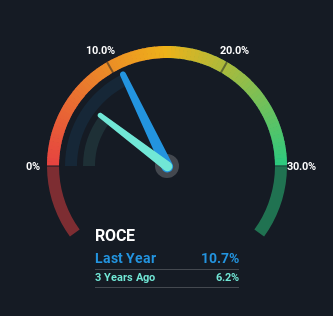
If you're not sure where to start when looking for the next multi-bagger, there are a few key trends you should keep an eye out for. Typically, we'll want to notice a trend of growing return on capital employed (ROCE) and alongside that, an expanding base of capital employed. Put simply, these types of businesses are compounding machines, meaning they are continually reinvesting their earnings at ever-higher rates of return. With that in mind, the ROCE of Vinci (EPA:DG) looks decent, right now, so lets see what the trend of returns can tell us.
What Is Return On Capital Employed (ROCE)?
For those that aren't sure what ROCE is, it measures the amount of pre-tax profits a company can generate from the capital employed in its business. To calculate this metric for Vinci, this is the formula:
Return on Capital Employed = Earnings Before Interest and Tax (EBIT) ÷ (Total Assets - Current Liabilities)
0.11 = €7.1b ÷ (€115b - €49b) (Based on the trailing twelve months to December 2023).
Therefore, Vinci has an ROCE of 11%. In absolute terms, that's a pretty normal return, and it's somewhat close to the Construction industry average of 10%.
View our latest analysis for Vinci

Above you can see how the current ROCE for Vinci compares to its prior returns on capital, but there's only so much you can tell from the past. If you'd like, you can check out the forecasts from the analysts covering Vinci here for free.
The Trend Of ROCE
While the returns on capital are good, they haven't moved much. Over the past five years, ROCE has remained relatively flat at around 11% and the business has deployed 63% more capital into its operations. Since 11% is a moderate ROCE though, it's good to see a business can continue to reinvest at these decent rates of return. Stable returns in this ballpark can be unexciting, but if they can be maintained over the long run, they often provide nice rewards to shareholders.
On a side note, Vinci's current liabilities are still rather high at 42% of total assets. This effectively means that suppliers (or short-term creditors) are funding a large portion of the business, so just be aware that this can introduce some elements of risk. Ideally we'd like to see this reduce as that would mean fewer obligations bearing risks.
The Bottom Line
In the end, Vinci has proven its ability to adequately reinvest capital at good rates of return. And the stock has followed suit returning a meaningful 67% to shareholders over the last five years. So while investors seem to be recognizing these promising trends, we still believe the stock deserves further research.
One more thing to note, we've identified 2 warning signs with Vinci and understanding them should be part of your investment process.
While Vinci may not currently earn the highest returns, we've compiled a list of companies that currently earn more than 25% return on equity. Check out this free list here.
New: Manage All Your Stock Portfolios in One Place
We've created the ultimate portfolio companion for stock investors, and it's free.
• Connect an unlimited number of Portfolios and see your total in one currency
• Be alerted to new Warning Signs or Risks via email or mobile
• Track the Fair Value of your stocks
Have feedback on this article? Concerned about the content? Get in touch with us directly. Alternatively, email editorial-team (at) simplywallst.com.
This article by Simply Wall St is general in nature. We provide commentary based on historical data and analyst forecasts only using an unbiased methodology and our articles are not intended to be financial advice. It does not constitute a recommendation to buy or sell any stock, and does not take account of your objectives, or your financial situation. We aim to bring you long-term focused analysis driven by fundamental data. Note that our analysis may not factor in the latest price-sensitive company announcements or qualitative material. Simply Wall St has no position in any stocks mentioned.
About ENXTPA:DG
Vinci
Engages in concessions, energy, and construction businesses in France and internationally.
Very undervalued with adequate balance sheet and pays a dividend.


